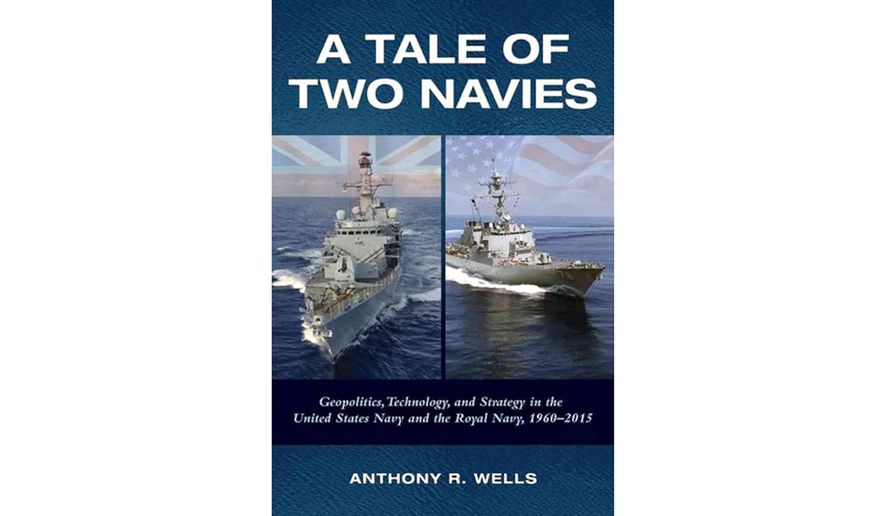OPINION:
A TALE OF TWO NAVIES: GEOPOLITICS, TECHNOLOGY, AND STRATEGY IN THE UNITED STATES NAVY AND THE ROYAL NAVY, 1960-2015
By Anthony R. Wells
Naval Institute Press, $35, 250 pages
In “A Tale of Two Navies,” we have a refreshing new look at the special relationship of Britain and America written by an Englishman. Anthony Wells, born in Coventry, a graduate of the Royal Naval College who served in the Royal Navy and then emigrated to America, became a citizen and worked for U.S. intelligence and the U.S. Navy.
In a brief introduction Mr. Wells writes that the U.S. Navy and the Royal Navy have a unique relationship within a “special relationship” forged during World War II by President Franklin Roosevelt and Prime Minister Winston Churchill. On Page 2 there is a photograph taken on board HMS Prince of Wales in Placentia Bay, Newfoundland, during a church service with Roosevelt and Churchill and hundreds of sailors on the main deck in the shadow of three of her huge guns on Aug. 10, 1941. It is a fateful moment of the Atlantic Charter Conference. Five months later the battleship Prince of Wales and battle cruiser Repulse would be lost in the Far East after a lengthy high speed run from the Atlantic — both sunk on Dec. 10, 1941 by land-based Japanese bombers staged out of Indochina.
In the words of Mr. Wells regarding this special relationship, “At its heart lay special intelligence sharing at the most sensitive levels, much of it focused on naval matters. Parallel to and coupled with intelligence activities ran a continuous thread of maritime strategic planning that bonded the two navies throughout World War II. This golden thread that contributed so significantly to ultimate victory in 1945 continued in the postwar period. By 1960, when this story of ‘the two Navies’ begins, the special relationship of the U.S. and Royal Navies had become entwined.”
During the 55 years from 1960 through 2015, Mr. Wells examines events central to the naval history of both the United States and the United Kingdom and the response of each navy to the Soviet Union throughout the Cold War.
Following the Cuban Missile Crisis in 1962, which showed how a president who had served in the Navy during World War II could use naval power to avert invading Cuba and was able to offset the frightening recommendations of Gen. Curtis LeMay and others who wanted a nuclear response to the Soviets. Then in December 1962, President John F. Kennedy and Prime Minister Harold Macmillan met in Bermuda and agreed to share nuclear submarine and strategic nuclear ballistic missile technology.
This agreement provided the United Kingdom with the Polaris ballistic missile capability, using British warheads and giving the U.S. Navy a long-term lease for a submarine base at Holy Loch in Scotland. Earlier, the British had been working on a way to modify World War II straight deck aircraft carriers for safer and more efficient jet operations by angling the landing area and using steam to power the catapults. Drawing on these British innovations we commissioned our first super carrier, USS Forrestal, with an angled landing deck and steam catapults in 1955. Meanwhile the Navy lost no time in modifying a number of World War II Essex class carriers and the three post war Midway class aircraft carriers.
Mr. Wells in his “Tale of Two Navies” takes us through the Cold War, stressing the importance of the maritime forces in maintaining our sea-based deterrent and supporting our expeditionary forces. His chapter on the Falklands Campaign of 1982, “A Real Shooting War at Sea,” is fast-moving with some excellent photographs. Chapter Four, “The Soviet Navy Challenges the U.S. Sixth Fleet and the Royal Navy,” is the most thought-provoking chapter (and the longest). It includes the Six Day War and an in-depth analysis of the intelligence networks that revealed how close we came to conflict with the Soviet airborne army in Syria.
At the conclusion of the book, Mr. Wells provides four pages of source notes, which are single paragraph summaries of each of the 12 chapters. These are very helpful in keeping a focus on future U.S. Navy and Royal Navy strategic issues.
There is no better example of the unique British ability to resolve seemingly intractable problems than the development of the aircraft ejection seat, which Sir James Martin undertook in 1942 when his business partner, Capt. Valentine Baker, was killed on a forced landing because there was insufficient altitude to “bail out.” Although it took seven years, James Martin built an ejection seat that saved an airman in 1949. Since then (up to February 2017) 7,514 air crew lives have been saved by Martin-Baker ejection seats. And that includes this reviewer, who walked away from an ejection on takeoff from Andrews Air Force Base in 1967.
• Thomas W. Schaaf Sr. is a retired Naval aviator living in Fairfax.




Please read our comment policy before commenting.